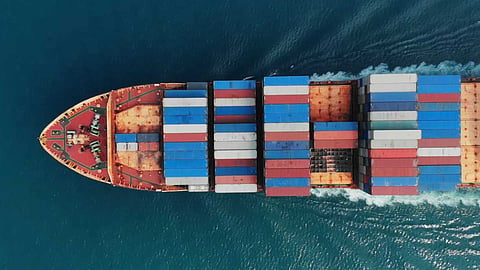Global Container Count: 13 Million TEU Too Many?
Over the past 2 years, congestion in the supply chain has led to a significant extension of the transportation time, not only in relation to the ocean-side delays, but also in relation to inland congestion and delays.
When the supply chain gets longer, there will naturally be a need for more containers, simply because each container is needed for a longer period of time.
Conversely, this also means that once the supply chain normalises, there will be a release of a significant number of containers, which are no longer needed.
To quantify that, in issue 564 of the Sunday Spotlight, Sea-Intelligence (S-E) looked at the data provided by Hapag-Lloyd and matched the transported cargo volume and the equipment fleet over a longer period of time.
This all comes with the caveat that Hapag-Lloyd’s operational performance in relation to their equipment is taken as a proxy for the entire market.
S-E started the analysis by looking at the development in both the size of the equipment fleet as well as the number of transported containers over the past 12 years.
This was followed by calculating the equipment efficiency, by looking at how many full loads of cargo were moved per container in the equipment fleet.
project44 Launches World's First Port Intelligence Solution
In 2010-2014, the effectiveness of the equipment fleet is relatively constant at 1.3 loads per container per quarter, followed by a lot of volatility in 2014-2017, and stabilising again at an average of 1.18 full loads per container in 2018-2019.
In 2020-2022 we see the effectiveness decline significantly to 0.95 loads per container in 2021-Q4, slightly improving to 0.98 in 2022-Q1.
Contemplating the normalisation of the supply chain, in 2022-Q1, Hapag-Lloyd needed an equipment fleet of just over 3 million TEU to move their cargo.
If the supply chain bottlenecks were removed now, Hapag-Lloyd would need 17% fewer containers in their equipment fleet, compared to what they have presently. If this is representative of the global market, there would be a need for 17% fewer containers than what we currently have.
The global container fleet reached 50 million TEU in 2021. If 17% of this becomes redundant, this equals 8.5 million TEU in excess equipment. Accommodating for the 4.5-4.8 million additional TEU to be delivered in 2022, and we end up with 13 million TEU of excess containers in 2023.
Read More: White Paper: Simple Steps to Decarbonize Deep-Sea Shipping


